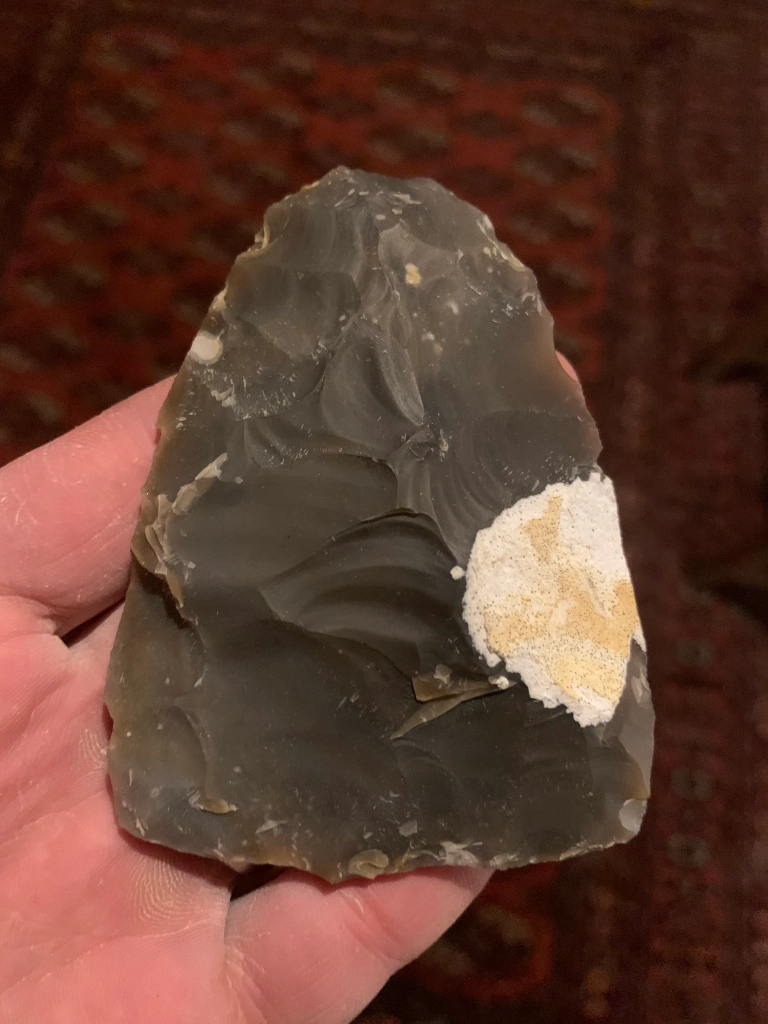
I destroyed two of the large flakes produced last week before I got to this with the third. It is a Neanderthal Bout Coupe, or flat based handaxe, and I like it.
Experimental production of stone tools

I destroyed two of the large flakes produced last week before I got to this with the third. It is a Neanderthal Bout Coupe, or flat based handaxe, and I like it.
I have had a bit of a ‘John day’ today. First thing I took Bella for a walk to the bottle dump. I found some blue glass fragments and a couple of interesting bottles, but no nice thick pieces.
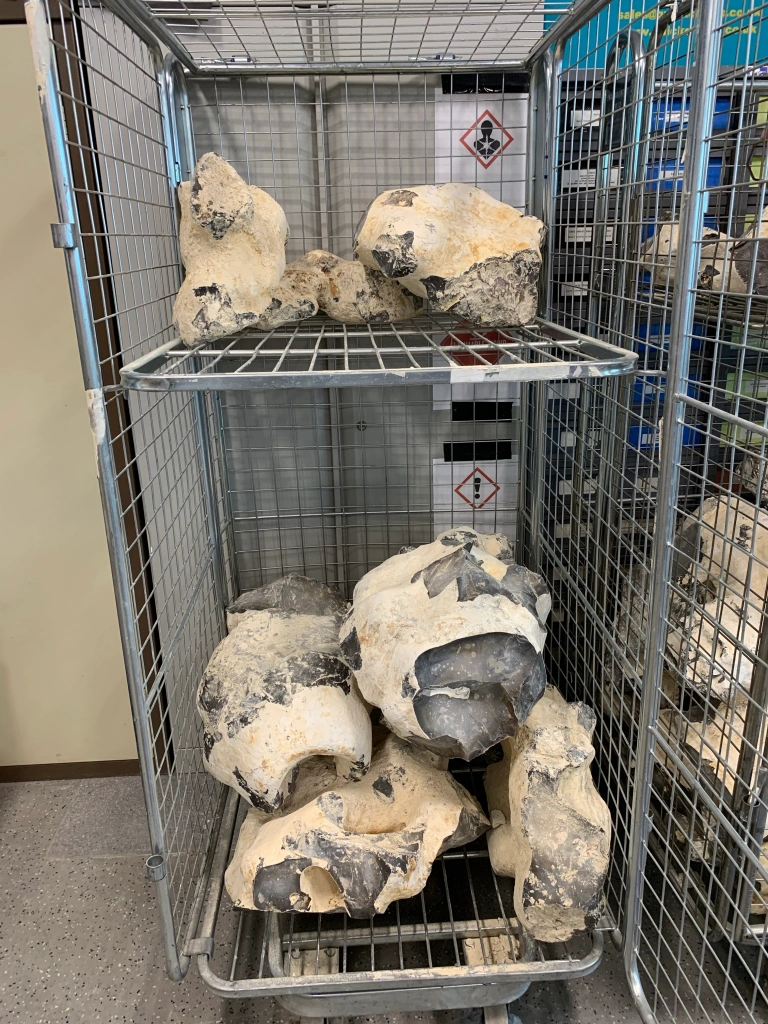
After a late breakfast of left over veggie Shepherds Pie I went into uni. As you can see, we have some very big nodules, inherited from Alice la Porta. When she was buying them I told her to specify big nodules, as our previous delivery had been largely small ones. I should have said medium size.
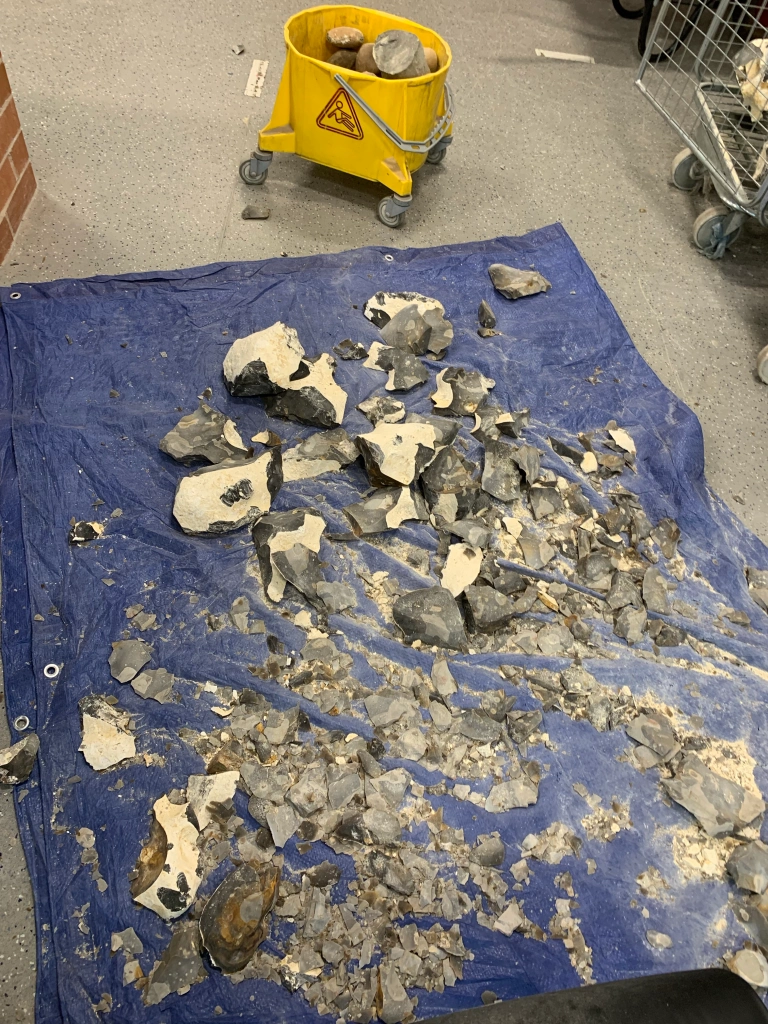
Anyway, today I wanted to try breaking one up to see how it would go. I chose what looked like the easiest nodule, with flat sections as ways in. I then proceeded to produce a series of large flakes, and a lot of small debris.
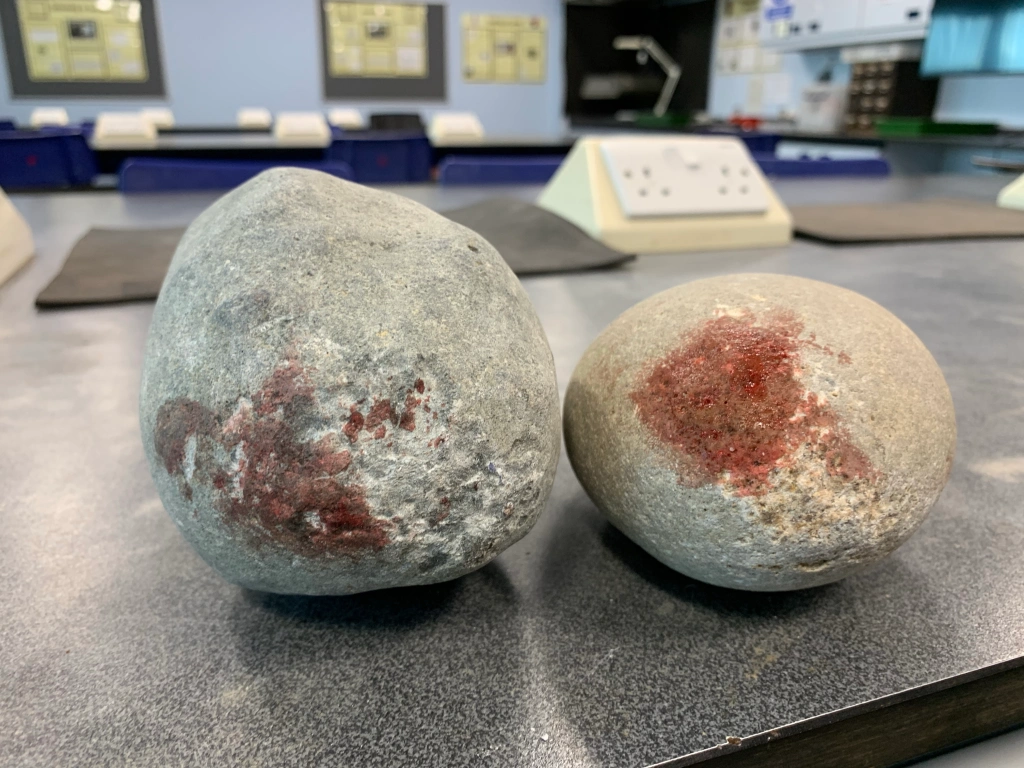
For the breaking up process I used these two hammer stones, and as you can see, I didn’t get off scott free. However, they did their job and I then wanted to make a handaxe from one of the flakes.
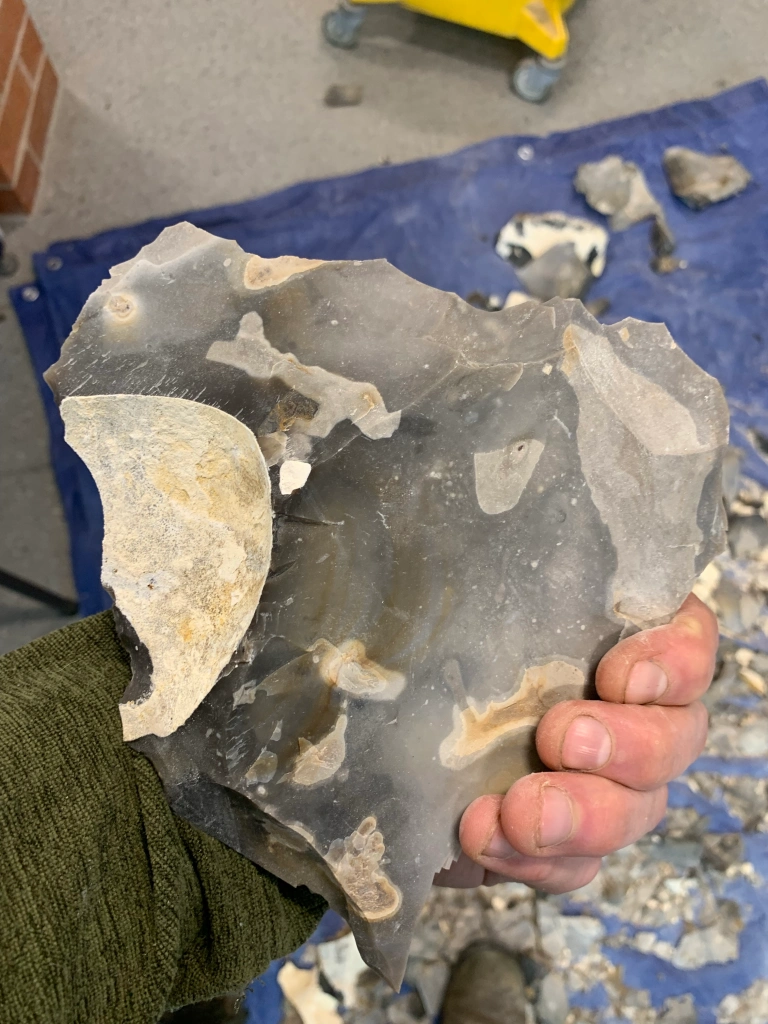
All together I had three goes and made two handaxes, and I really like the one made from this flake. I learned from the glass handaxe I made last week, and this time stayed focused on preparing platforms and getting long thin flakes off.
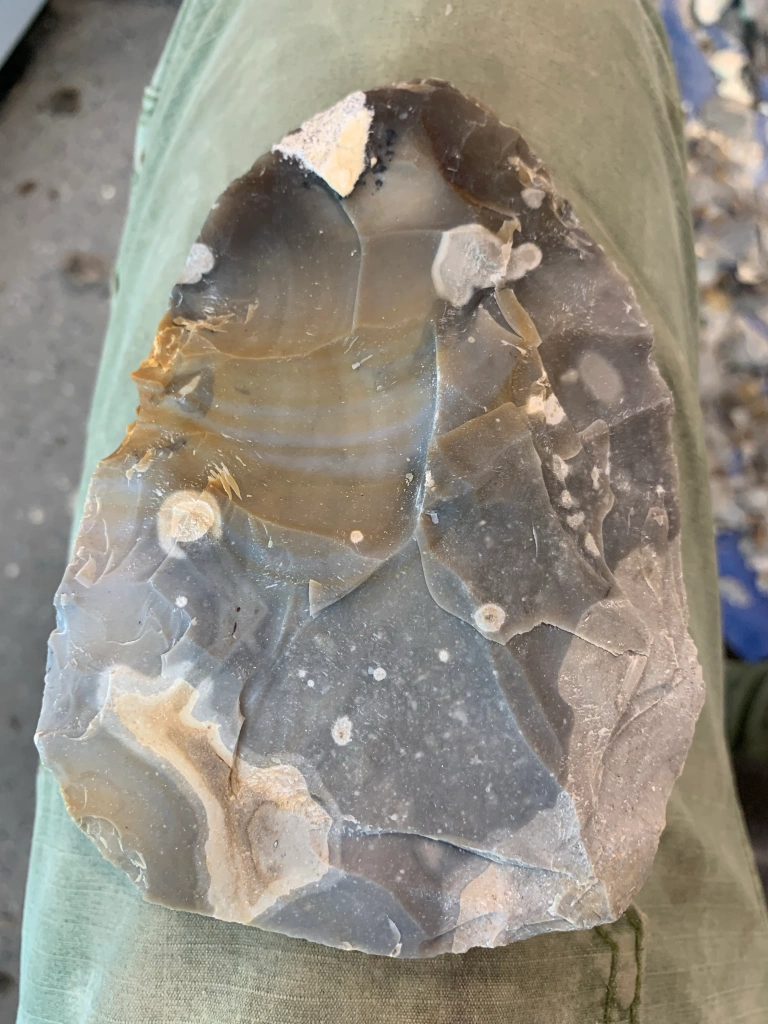
One of the transverse flakes came off nicely but stepped in the centre of the handaxe (see left hand side with brown stripes).
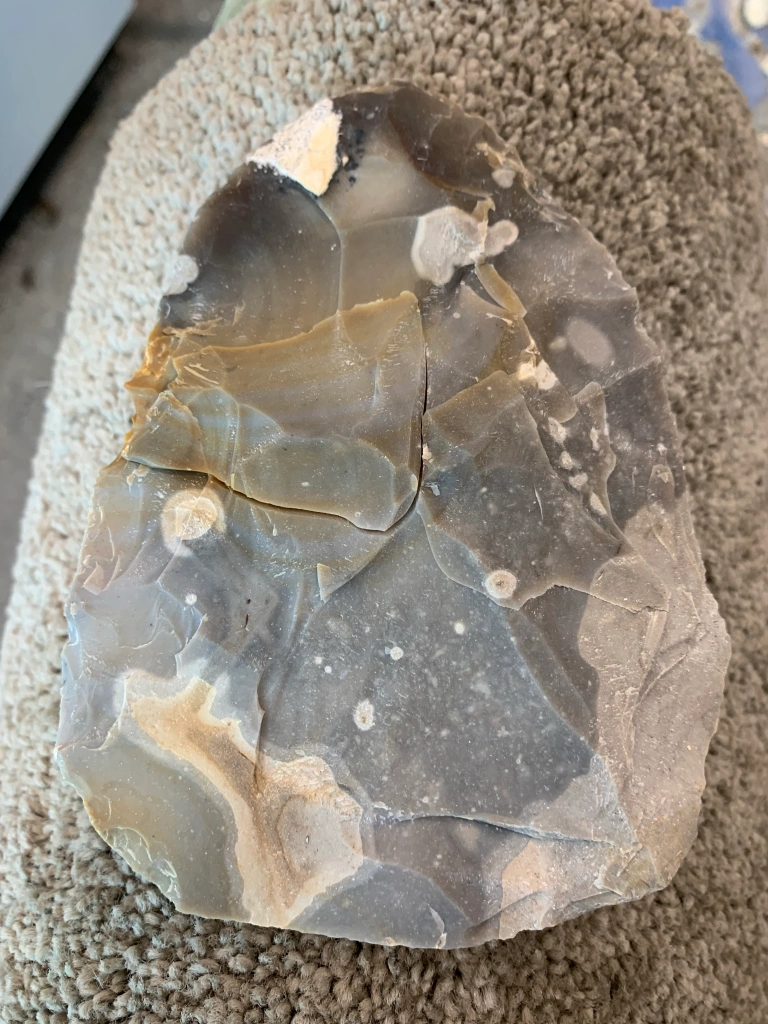
So I did one of my special techniques that I learned from a Bronze Age knapper, and fitted the flake back in. I then whacked it again and successfully removed the step.
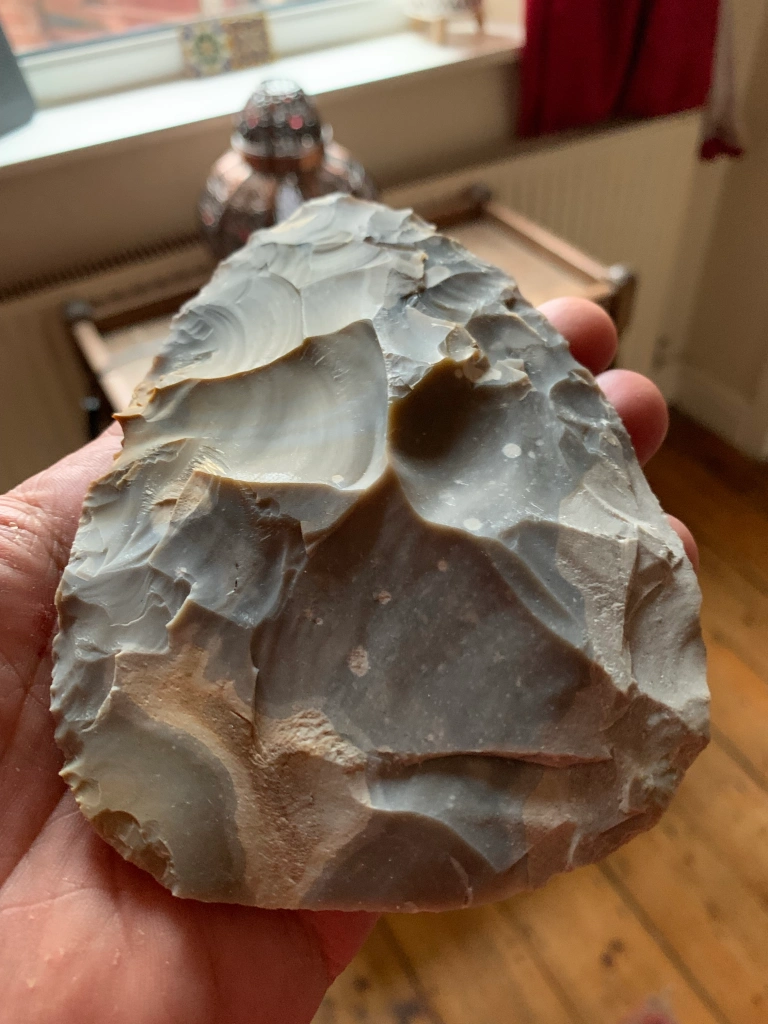
If you look at the flake scar on the right hand side you can see the negative bulb of percussion in the centre of the handaxe illustrating the process.
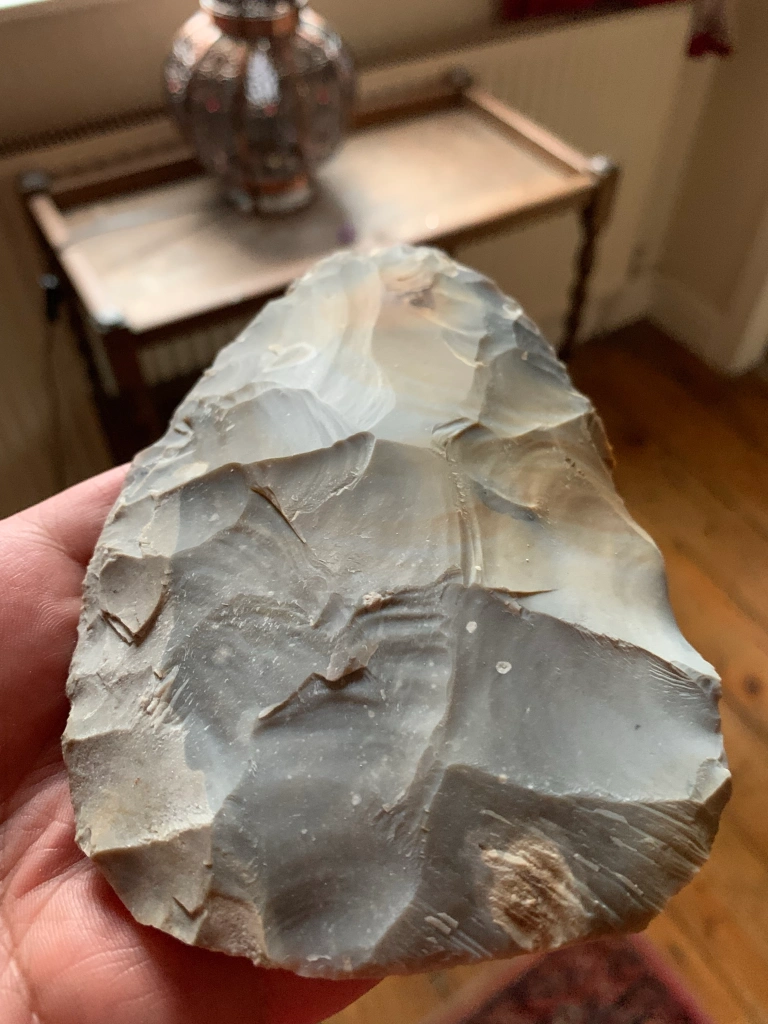
I am very pleased with this one, it is large with nice long flat removals. I don’t know if a Homo heidelbergensis knapper would have been concerned about the step fracture, however that process was immensely satisfying for me and gives the handaxe some personality. Happy days.
I don’t normally destroy perfectly functional things in order to make my stone tools, however…I found this nice thick glass ashtray in Oxfam and it reminded me of the glass slabs I want to produce with Nacho.
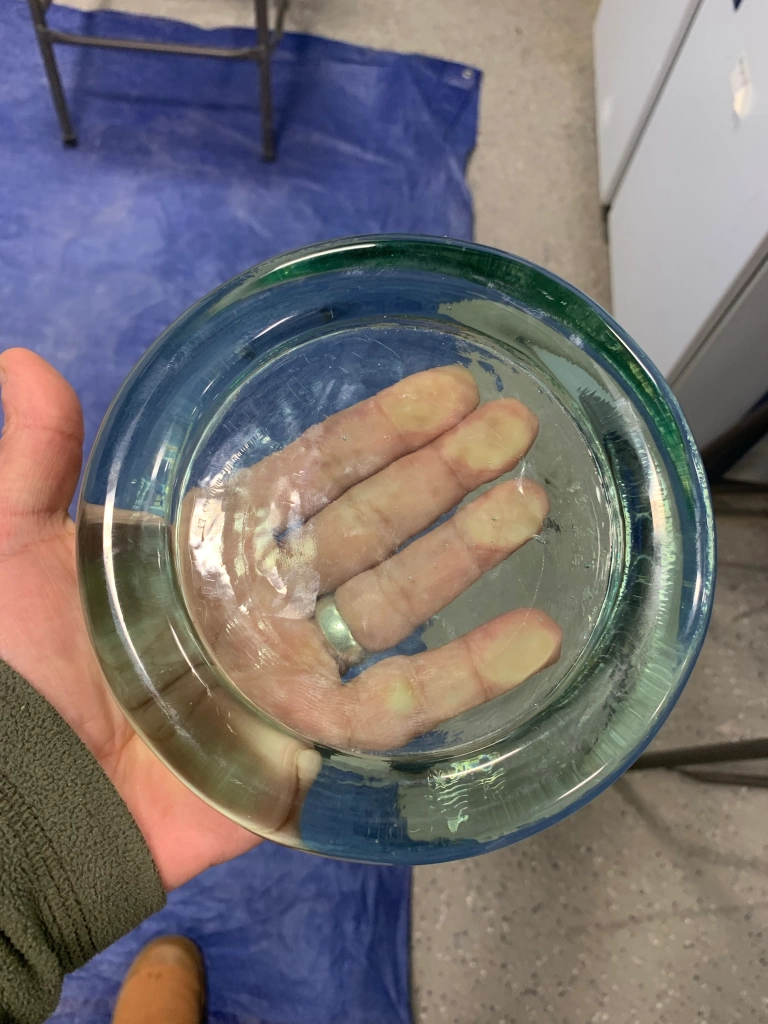
So £3.99 and 24 hours later I was sat in the lab with a small hard hammer. The glass was really good to work even if it took me a while to get rid of the ‘walls’ of the ashtray.
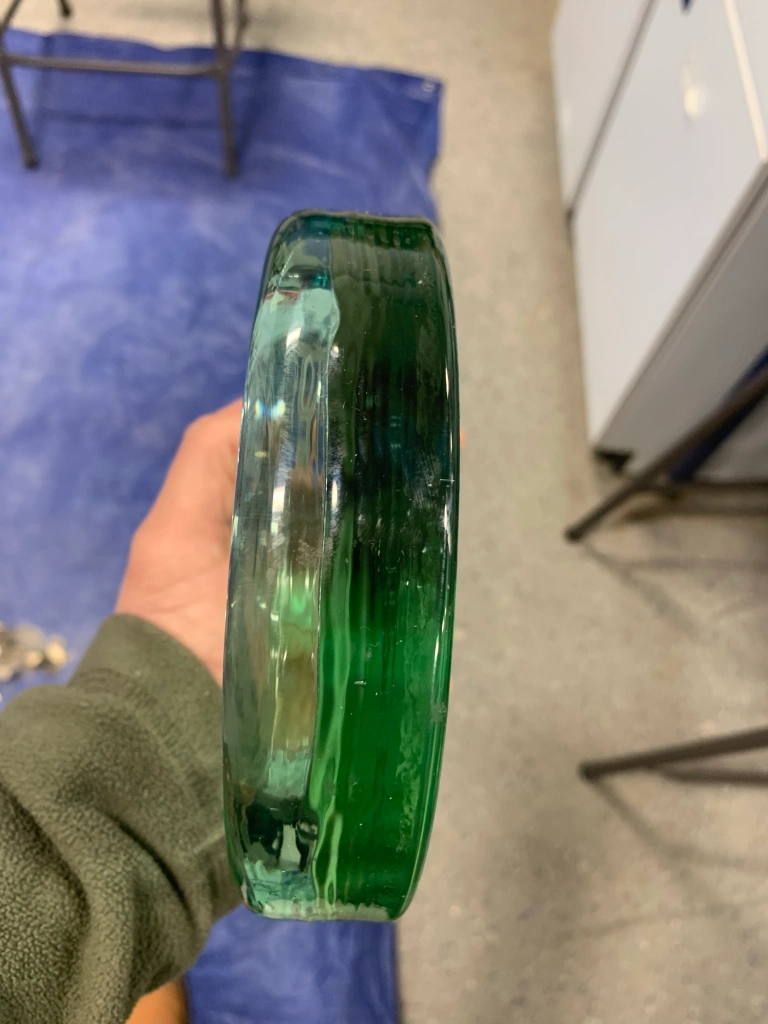
Like the older glass I am used to, this ashtray glass had bubbles in it. I knew what I wanted, a large ovate handaxe, and my earlier removals, when I had more material were better. I have some nice flakes that will be good for arrowheads at some point.
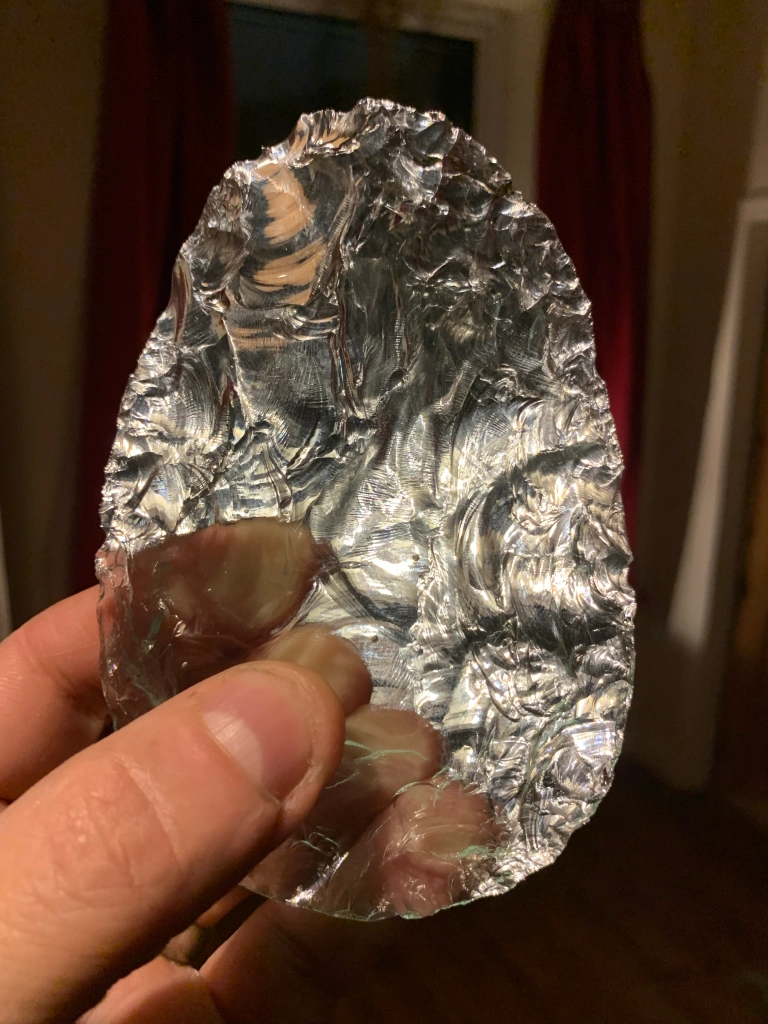
It looks half decent, is fully bifacially worked (no original surface left) and I have retained a good size. However, it is not my best. Harder to see from the pics is a step fracture ‘island’ on one face. I relaxed a little and went ‘intuitive’, which felt right, but failed to produce descent removals.
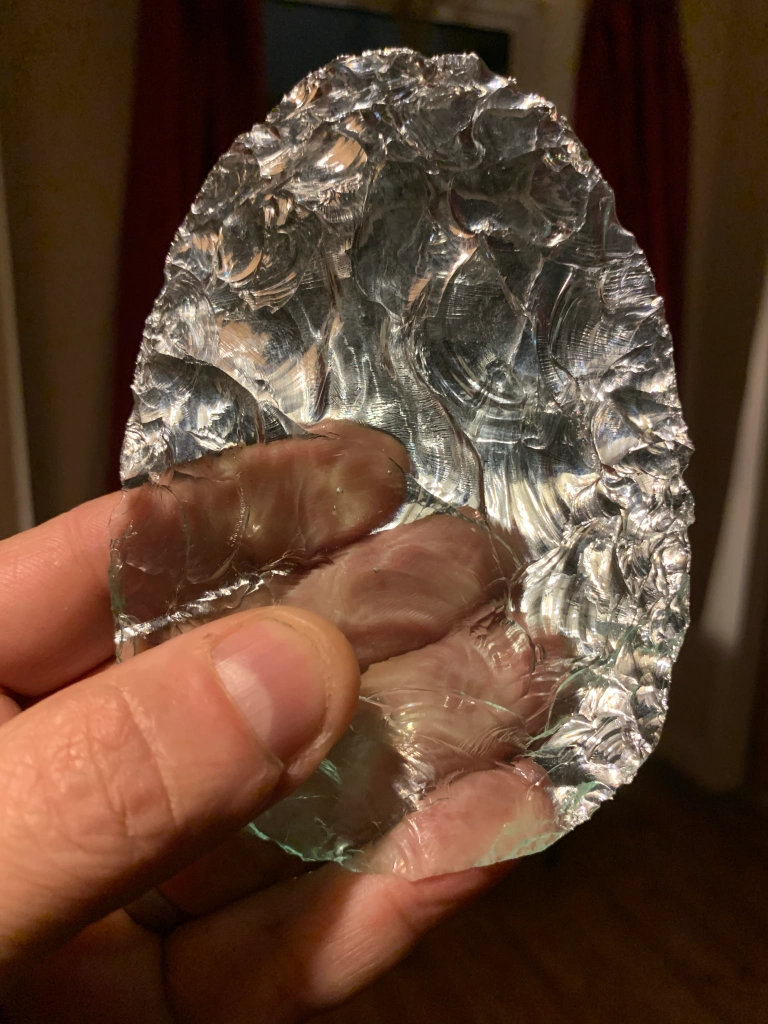
I was concentrating more on outcome than process, and in doing so stopped giving each removal the due consideration it deserved. By the time I realised I didn’t any longer have a good way in to remove the steps. If I really wanted to make it into something I like I would lose size, and it would end up like many of my smaller ones that are either made from smaller pieces, or like this, takes me lots of removals to get it ‘right’. Anyway, the hour in the lab was the thing. It’s been a while and it was great.
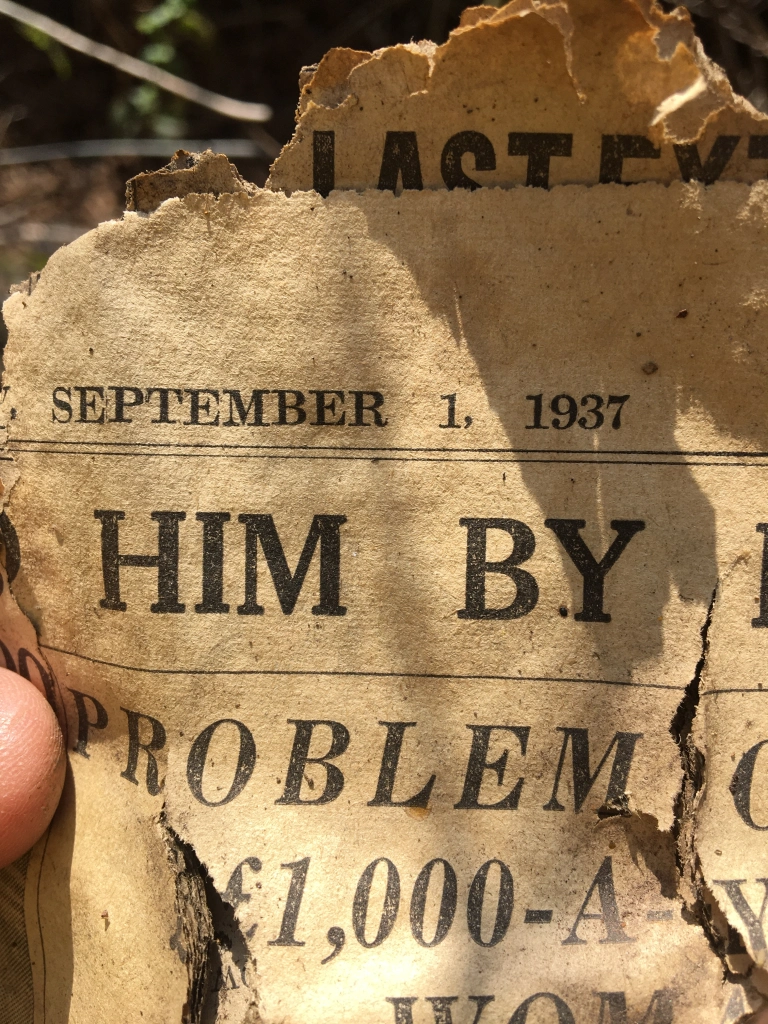
This afternoon Roxanna, Bella and myself went to the bottle tip. I thought from the style of the earliest bottles it was 1940s material and this newspaper from the site indicates late 1930s.
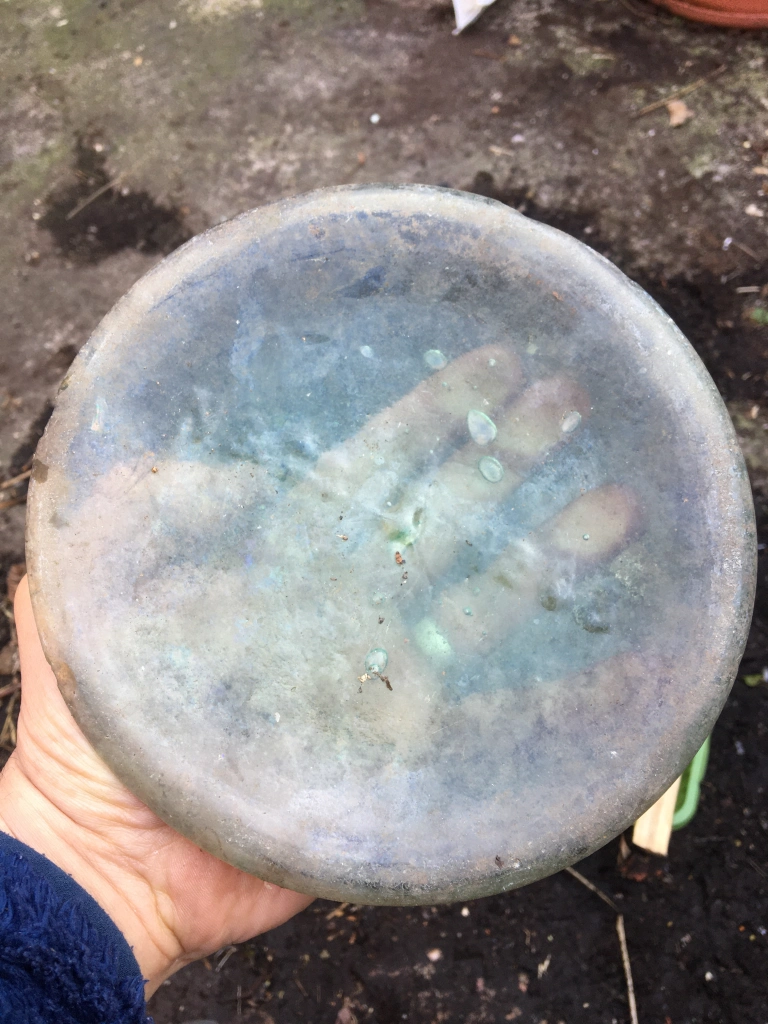
I was looking for big pieces and at first thought this was a metal pan lid. It was very concave and so needed considerable reduction to get it flat, but apart from a couple of irritating step fractures the glass behaved really well.
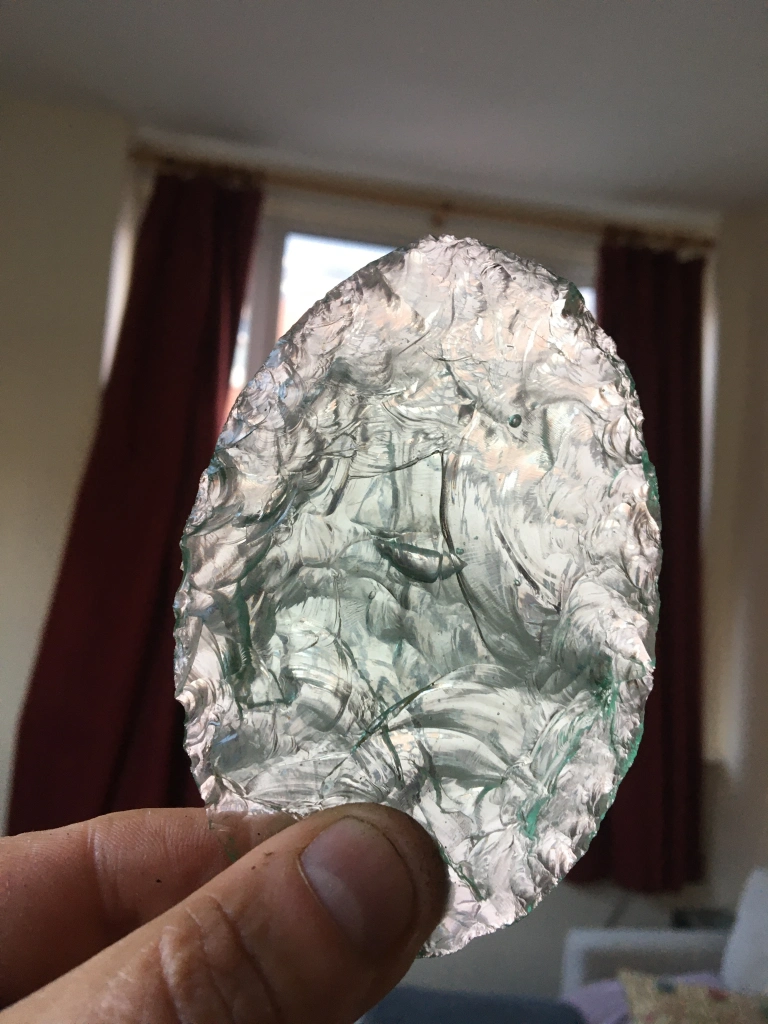
I took a few risks with this, but well prepared platforms and well behaved material led to this nice and lumpy but symmetrical ovate. Roxanna is not as keen on the bottle tip as me so we went to a cafe afterwards, to have some daddy daughter time…on our phones 😐

I mentioned in the last post how this very knappable material was not present in the museum lithic collections or associated text books for the area of Tuscany we were staying in.

I really enjoyed collecting these materials, and they were mostly eroding from a low wall that ran along the path to the house. I have realised subsequently that in fact all the pieces I picked up were from humanly produced structures.

Quarrying for materials is generally accepted to be part of the Early Neolithic, and in Britain some of the earliest monuments are flint mines. The Radiolarite (if that is what it is) may not have been easily available, or available at all to the Middle and Upper Palaeolithic populations using the area if it in fact comes from a deep stratigraphic context.
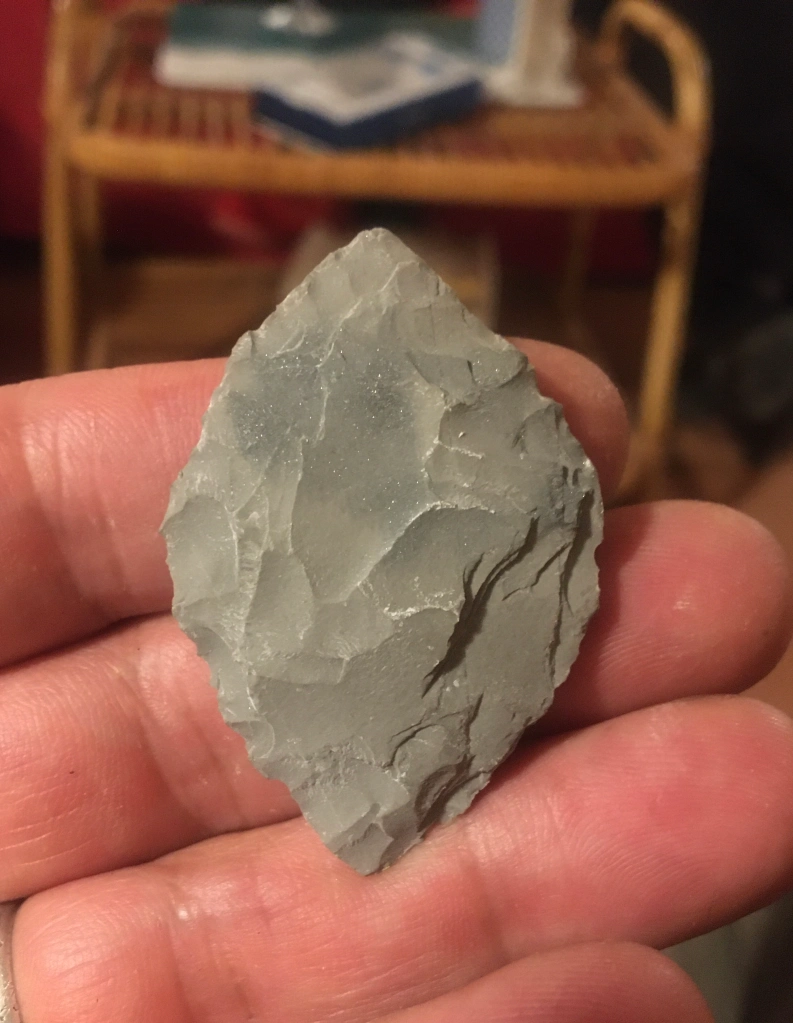
So my materials collection experience, whilst useful for getting to know the Radiolarite and its properties, was very much a post prehistoric experience, and actually more similar to my visits to the bottle tip. Those are my thoughts from the experience and evidence to date. Looks like I will have to come back to Tuscany if I want to categorically find out….
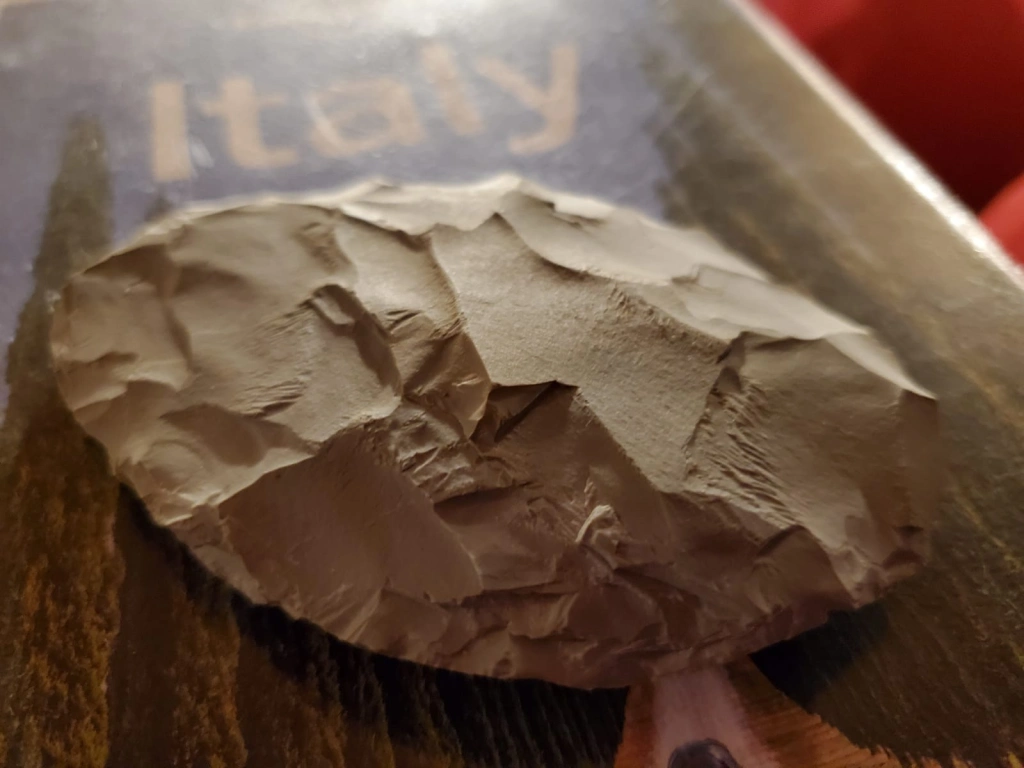
We are staying with a friend, David, in their Tuscan farmhouse villa, and the place is literally surrounded by this amazing knappable material.
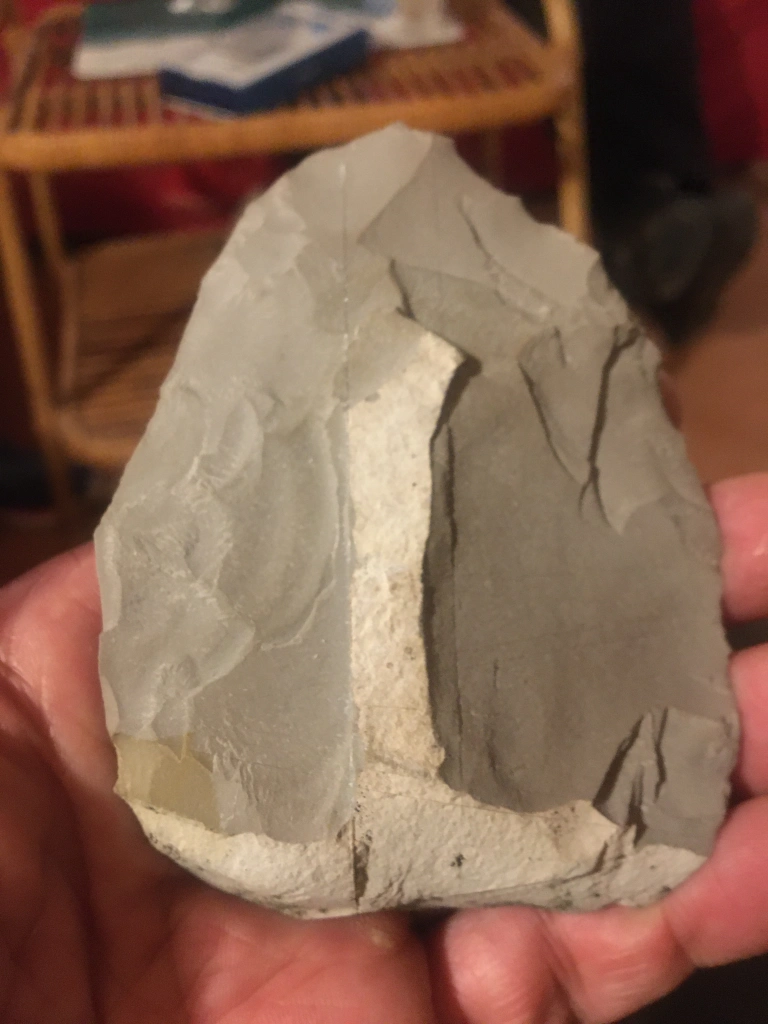
It’s interesting as it seems to break up into tabular form, but also has linear inclusions running through it, perpendicular to the tabular planes. In the above photo you can see how the flakes stop as they run into the inclusion line.
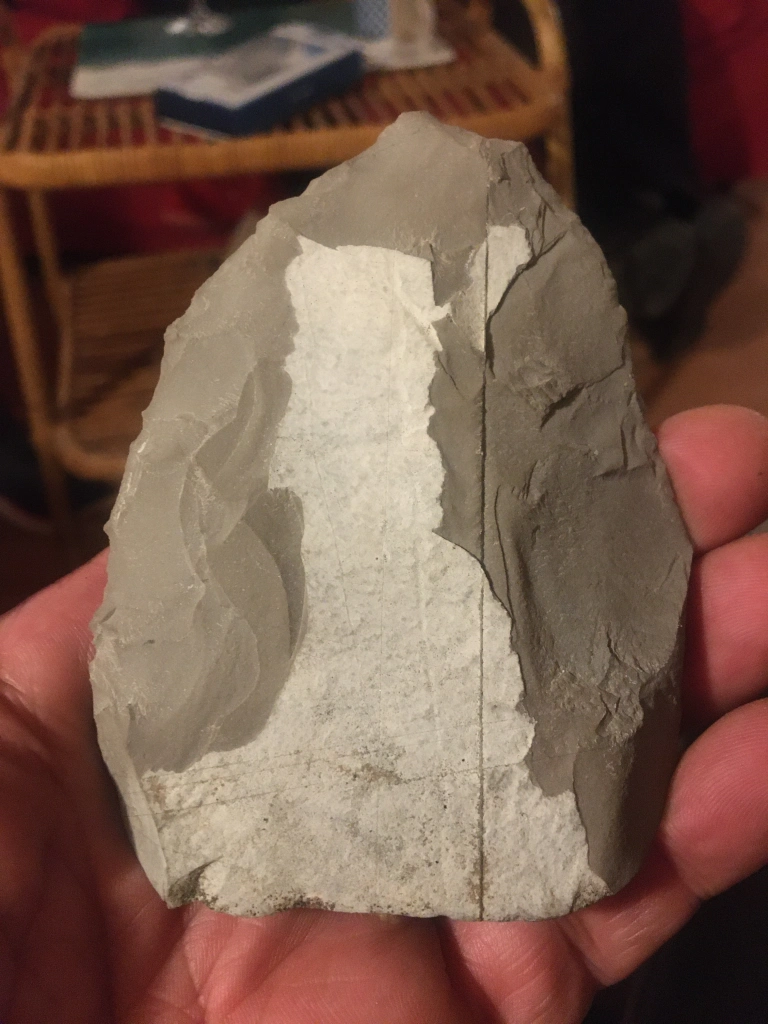
The inclusion line is perhaps more obvious on the other face. A quick Wikipedia search suggests it is Radiolarite chert, and a visit to the local museum gives the impression that stone tools found in the area were made from an imported flint, not this material.
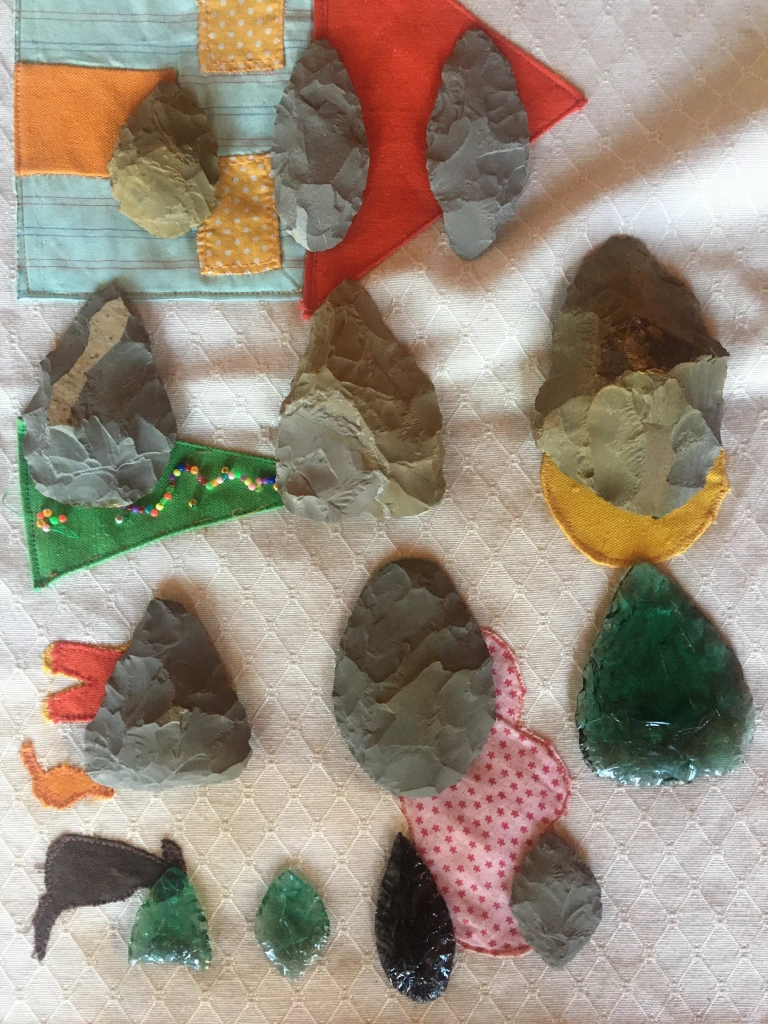
Anyway, I am bringing the first two artefacts home, the rest are for David, our host, and his neighbours who made the mistake of expressing an interest in what I was doing.
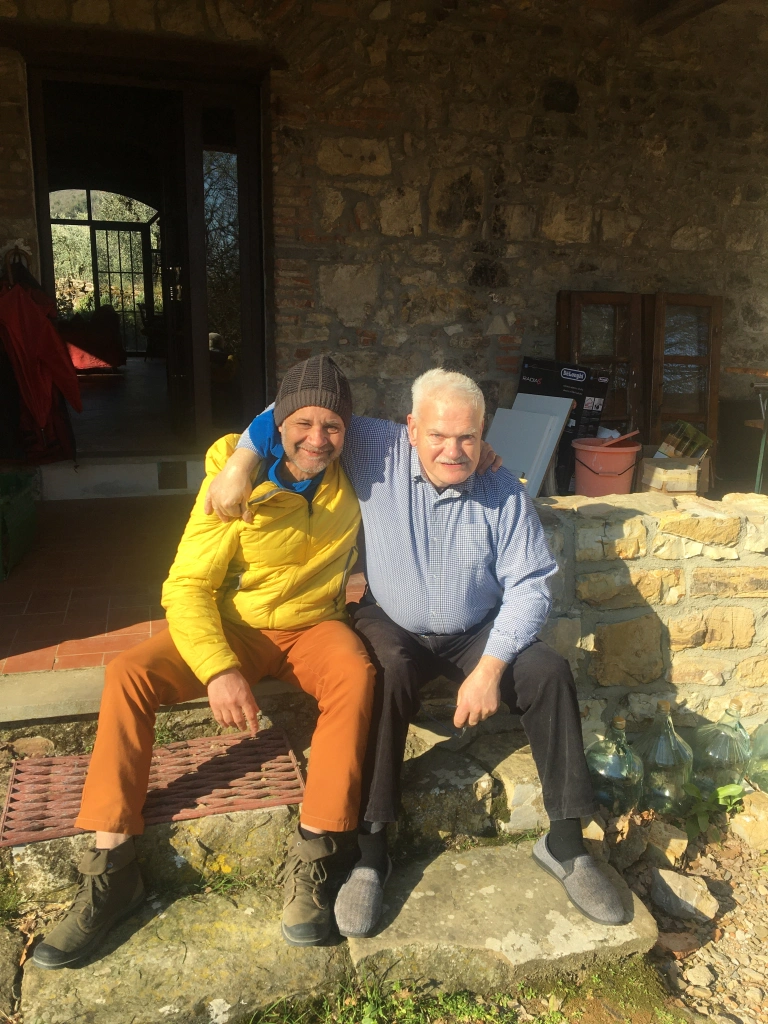
What a lovely week, spent with David, Chrissy, Penny, Karen, and my new friend, Radiolarite chert.
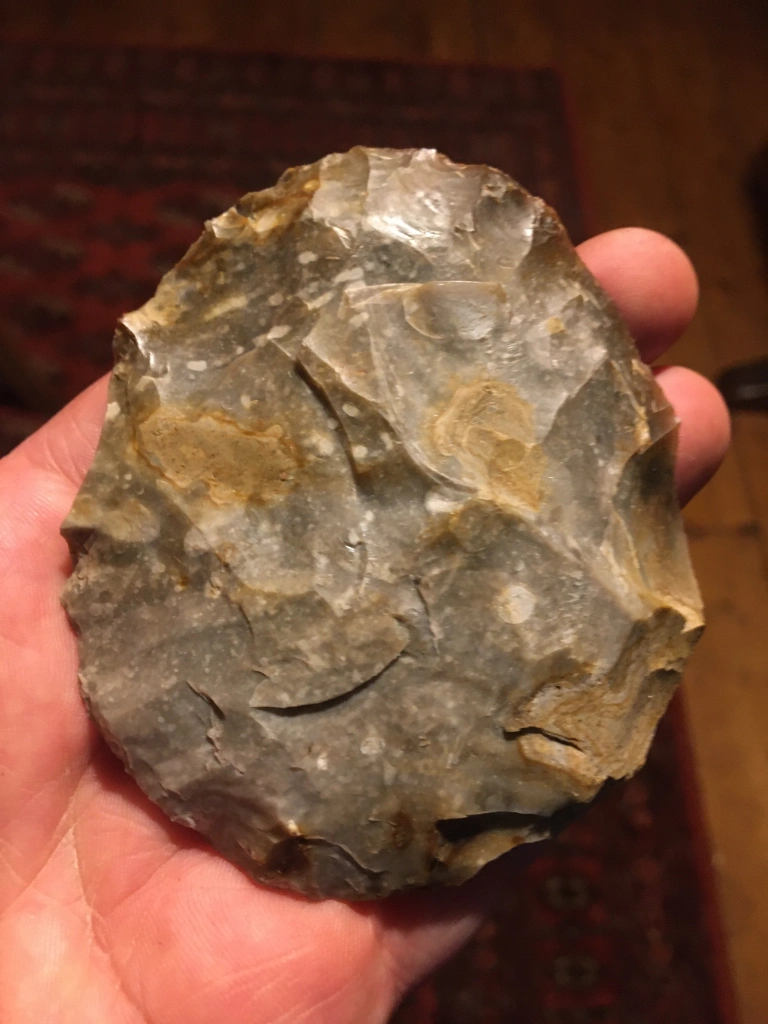
Thanks to Alice la Porta we now have the best part of a tonne of flint nodules in the Teaching Lab. Thank you Alice! Earlier this afternoon I went to a talk by Julian Thomas about excavations at the early Neolithic site of Dorstone Hill in Herefordshire. Of particular interest was the pattern of rock crystal deposition. Whilst flint was found across the site, rock crystal was almost exclusively associated with cremated remains.
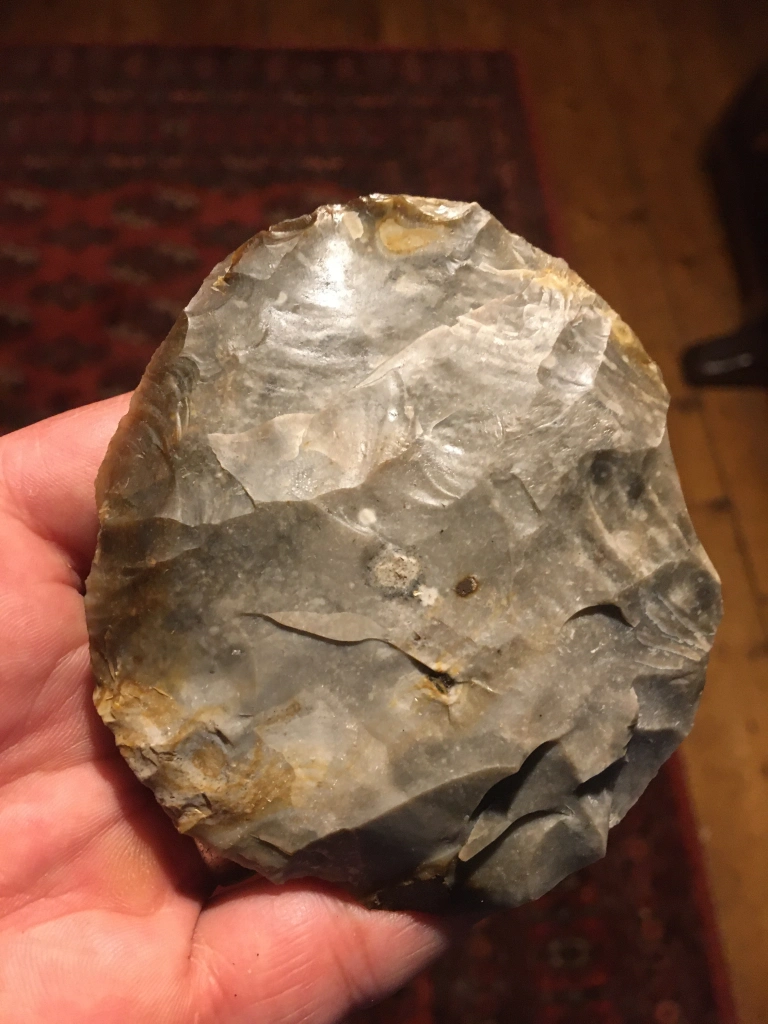
And whilst present in the form of very small pieces of debitage, no rock crystal tools were recovered, and the small size of the debitage suggests none were produced. The process of reduction seems to have been the thing. This is in stark contrast to the typological focus of modern archaeology discussed in Grace’s previous post.
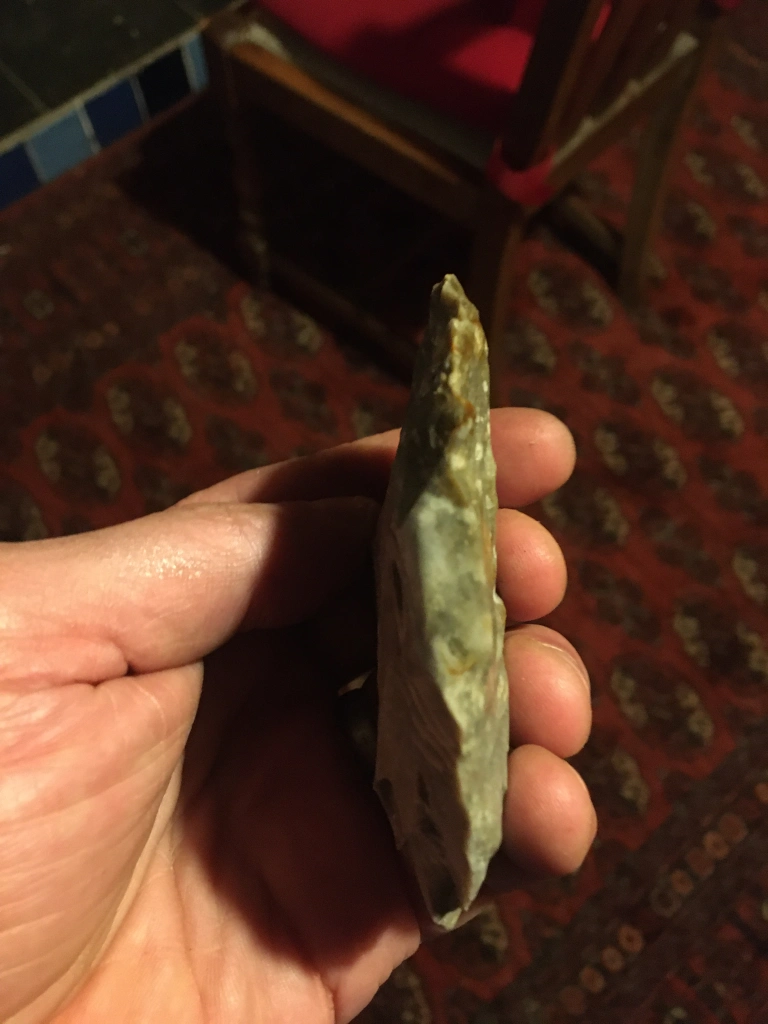
Anyway, at about 5.30pm I found myself in the lab with a large hammer stone reducing a large nodule into manageable flakes. I have posted some pics of one of the handaxes made, but to reiterate, the process is the thing. I like the handaxe but I stole the 50 minutes or so of the day when I could be alone in the lab making something. Why is this process so precious?
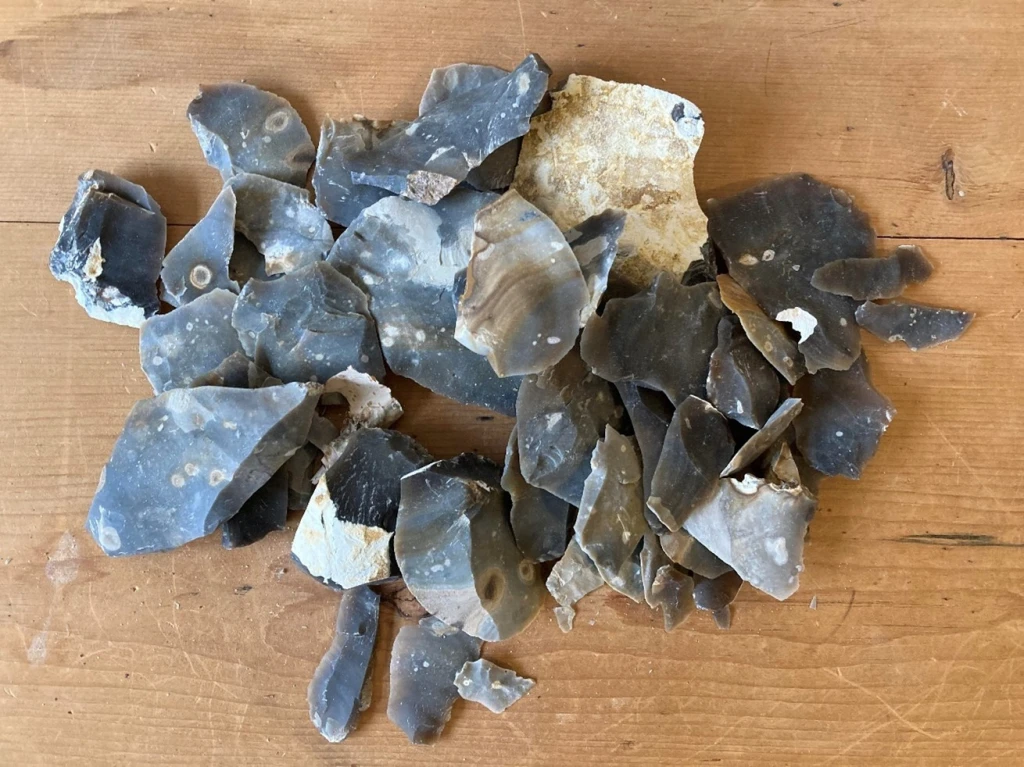
Figure 1: Contents of a bag of worked flint given to me by John to draw
While reflecting on my first attempt at flint knapping at the hand-axe making workshop I was struck by how unintuitive the process of flint knapping is. For a novice like myself, the act of knapping flint with the objective of producing a recognisable tool was not only difficult to physically do, but almost impossible to conceptualise. I assumed that because I had some understanding of the theory of flint fracture mechanics it would come naturally to me. It is also likely that, on some level, I had assumed that because flint-working is perceived as so simple and such a fundamental part of the ‘natural’ behaviour of hominins, that the leap from theory to action would be small. But, as became obvious to me after attending the workshop, it is not just the development of physical knapping techniques that requires practice, but the very ability to understand the material.
It is easy to underappreciate the challenge of flint knapping before trying it out for yourself, particularly as the material itself feels unfamiliar. But nonetheless, just as Laura wrote about in the previous blog post, being surrounded by others – being able to watch what they are doing, mimic them or ask them questions – was also how I was able to take the very first steps in learning what to do. The social aspect of flint knapping led me to reflect on an essay I wrote during my Master’s course on the utility of typologies based on the chaîne opératoire (typologies are methods used to classify artefacts and the chaîne opératoire refers to the method of understanding artefacts based on how they are made, rather than what they look like).
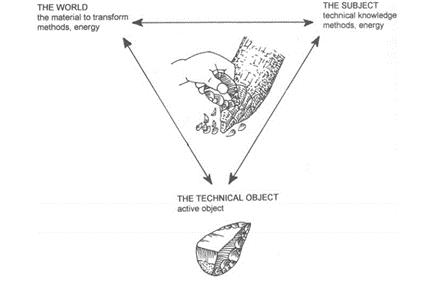
Figure 2: The relationships inherent in lithic tool manufacture (Geneste and Maury, 1997)
The chaîne opératoire appealed to me as it moves away from thinking of artefact types as static and provides room to think about why and how artefacts change over time. Proponents of typologies based on the chaîne opératoire argue that the methods by which people make things – their learned physical habits – are a more accurate indicator of cultural identity than artefact form or design, which can be replicated with different techniques (Kuijpers, 2018; Manclossi and Rosen, 2019; Roux, 2019; Tostevin, 2011). Crucially, physical habits are learned from an early age from skilled members of the community and, therefore, are a product of social relationships. Taking part in the flint knapping workshop allowed me to better understand knapping as a social activity, and thereby the relevance of the chaîne opératoire in artefact analysis. This was especially the case once I realised that ‘skill’ refers not only to the physical process of doing something, but the very way we understand it.
The principles of the chaîne opératoire have been used to inform lithic typologies for decades. Harold Dibble’s (1987) study of scraper morphology is the quintessential example of this in demonstrating the importance of understanding knapping as a process, as opposed to simply being able to identify the end-product (Figure 3). Vital for studies of lithic chaîne opératoires is the analysis of debitage, which provides valuable information on the techniques used to work a core. However, the typologies currently used in British scholarship on lithics are designed to describe the exact form and shape of clearly identifiable tools (see Figure 4). There remains no coherent vocabulary to describe the debitage produced in the knapping process, and we continue to rely on the vague terms, ‘blade’, ‘flake’, ‘chip’, ‘chunk’, ‘spall’, which tell us very little about the techniques used in their production. Through the process of experimental knapping, and watching how much debitage was produced (versus how many typologically clear ‘end-products’ were produced) I began to reflect again on how much more detailed and meaningful the archaeological record could be if we moved away from ‘morphological types’ and focused instead on the processes by which things are made. For, if this were the case, there would be a much greater incentive to describe debitage in detail.
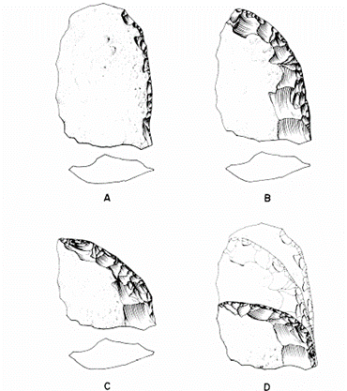
Figure3: The different phases in the reduction of a scraper, which were originally described as separate ‘types’ (Dibble, 1987: 112)
The problem with British typologies is felt especially in commercial archaeology, where the description of artefacts by type is often the only information recorded about them. Commercial archaeology works on the premise that the destruction of archaeology can be mitigated by the production of archives, or “preservation by record” (Andrews et al, 2000: 527). This means that the archaeological report produced at the end of each excavation is the only way in which archaeological knowledge produced can be kept and disseminated. It is therefore especially important that such reports use accurate and meaningful typologies. Moreover, given that commercial companies are often under strict time and financial pressure to complete report writing (Davies, 2017: 185), the use of typologies to describe lithics (typically in an Excel spreadsheet) is generally preferred to the time-consuming methods of measuring and drawing.
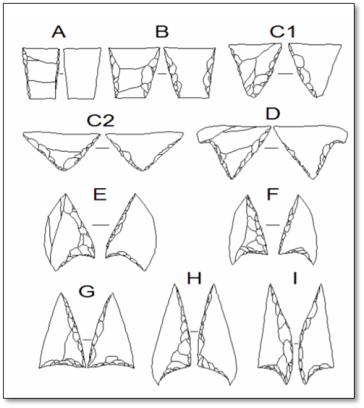
Figure 4: Clark’s (1934) typology of PTD arrowheads, reproduced by Ballin (2021: 28)
As someone who is interested in questioning the typologies we currently use in lithic scholarship, but is also keenly aware of their practical necessity, especially in the world of commercial archaeology, attending John’s hand-axe making workshop was fascinating and thought-provoking. My goal in learning to knap flint is not to make impressive flint artefacts. Instead, I am most interested in understanding how flint works, and the choices a knapper makes in order to shape their material. I hope that the result of this will be an ability to better read those choices from flint assemblages, with a view to learning about how patterns of craft production have changed throughout prehistory.
References:
Andrews, G., Barrett, J.C. and Lewis, J.S., 2000. Interpretation not record: the practice of archaeology. Antiquity, 74(285), pp.525-530.
Ballin, T. 2021. Classification of Lithic Artefacts from the British Late Glacial and Holocene Periods. Oxford: Archaeopress.
Davies, D. 2017. The Development of Archaeological Post-Excavation within British Professional Archaeology. BAJR Guide Series.
Dibble, H. 1987. The interpretation of Middle Palaeolithic scraper morphology. American Antiquity. 52: 1. 109-117
Geneste, S. and Maury, J. 1997. Contributions of Multidisciplinary Experimentation to the Study of Upper Palaeolithic Projectile Points. In Knecht, H. (ed.) Projectile technology. New York; London: Plenum Press 165-189
Kuijpers, M. 2018. A sensory update to the Chaîne Opératoire in order to study skill: perceptive categories for copper-compositions in archaeometallurgy. Journal of Archaeological Method and Theory, 25(3): 863-891.
Manclossi, F, and Rosen, S. 2019. Dynamics of Change in Flint Sickles of the Age of Metals: New Insights from a Technological Approach. Journal of Eastern Mediterranean Archaeology and Heritage Studies. 7. 6-22
Roux, V. 2019. Ceramics and Society: A Technological Approach to Archaeological Assemblages. Cham, Switzerland: Springer
Tostevin, G. 2011. Levels of Theory and Social Practice in the Reduction Sequence and Chaîne Opératoire Methods of Lithic Analysis. PaleoAnthropology. 351-375
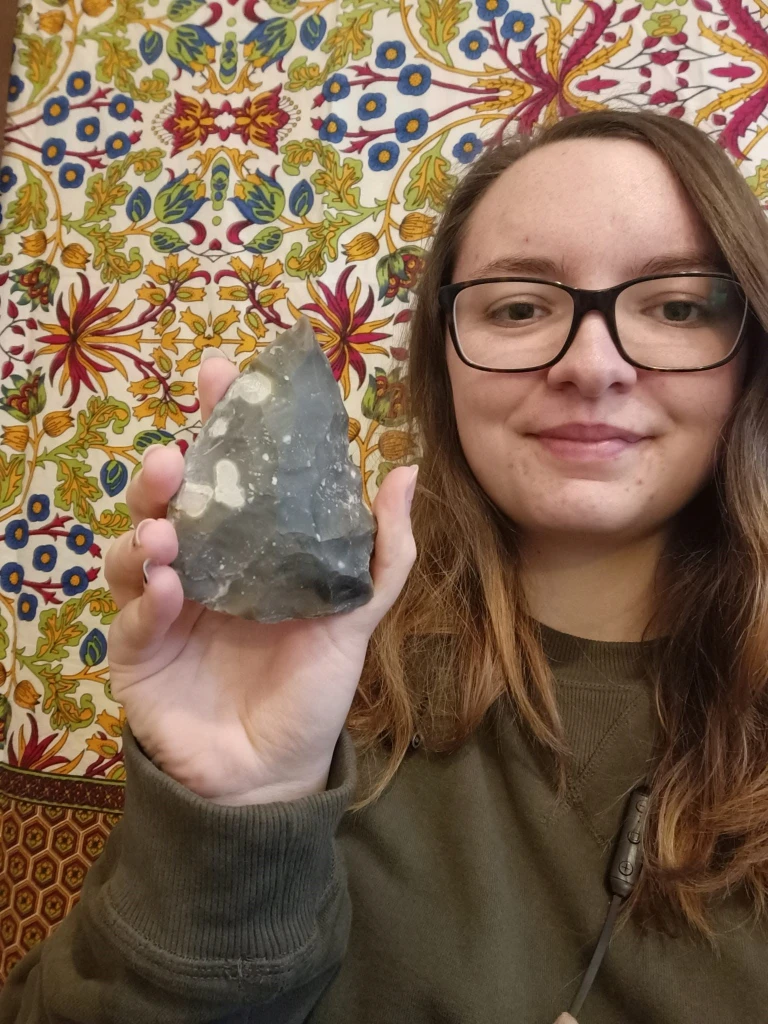
Flint working was an entirely new experience for me but getting to approach the material in a group environment made it a far less daunting task. I have knapped before, but only with glass bottles – easy to acquire as a student and much cheaper than flint! Glass behaves itself generally and you can predict where and when it will facture (mostly) making it a great starting material for knappers. I have no right to claim any decent knowledge of knapping or the skills that come with it, but I have managed, after many (many!) breakages, to form a neat little collection of glass arrowheads for myself.
I felt somewhat confident going into the flint knapping workshop John was hosting. I had seen the flint before, but I had never worked with it. We were given a detailed run through of how the flint reacts and how we should react to the flint, thinking of it as working together rather than just working on a material. Alice la Porta showd a video of a professional American knapper who created a beautiful flint axehead in just 25 strikes – a rather impressive and somewhat intimidating display of skill.
We started trying to make our own scrappers after a demonstration from John, and it’s fair to say mine did not turn out so well. I began with a decent palm-sized piece of flint which ended up about the size of my thumb with no real clear edge that could be used as a scraper. I tried again and again with flint flakes I found on the floor (I didn’t want to waste any good bits with my terrible practice blows) but didn’t have much luck. Flint was far harder to work with than I had anticipated and certainly much harder to knap than glass. I spent a good hour or so working on scraps trying to make a scraper before we moved onto looking at handaxes. Oddly, working towards a handaxe with the flint was much easier for me – I could visualise what I wanted a lot better and working with a larger piece of flint made me much more confident in my hits with the soft and hard hammers. Perhaps it was because I was used to working towards a similar goal that I set myself when making glass arrowheads, getting full surface removal of cortex and shaping the material, that I found making the flint handaxe easier to understand. This does not mean, however, that I had any clue what I was truly doing and was solely relying on the flint to help me and suggest areas to work on next. I did, in the end, leave with a beautiful handaxe I am very proud of (after some help from John).
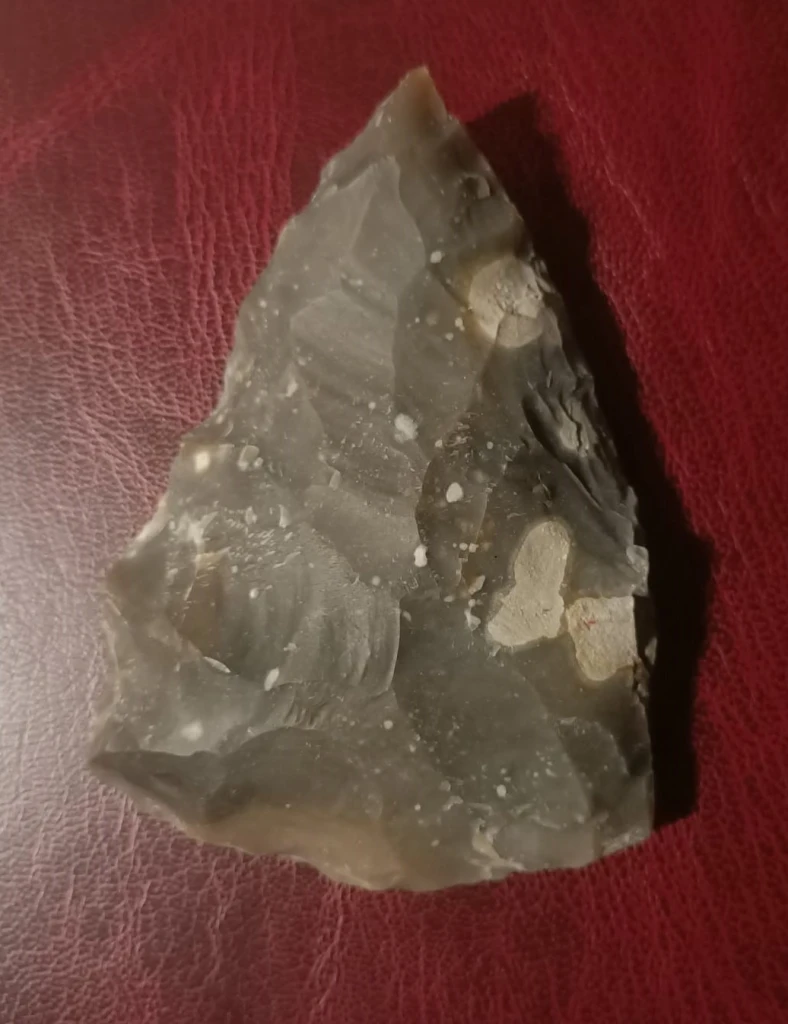
What I took away from this experience was that knapping does not have to be a lone effort. Beginner knappers, such as myself, need help and guidance from the more experienced, and even other beginners who might be catching on to some of the tricks faster. Though it is a personal creation does not mean a community effort cannot go into its manufacturing. I personally believe the experience would not have been as enjoyable had I been left alone in a room with an instructional video to watch and learn from. People help people when it comes to these kinds of workshops, whether that’s the teacher or other learners, community is an important part of the learning and creation process.
It took a long time for me to get used to working with the characteristics of flint as I was so used to glass. I had to relearn a lot of what I knew about knapping, but it was an eye-opening experience as it just goes to show how skills can always be developed and adapted to new (and more difficult) materials. This workshop was an excellent chance for me to make something I could be proud of, but also learn through others: there was such a variety of people at the workshop, professors, other students, commercial archaeologists, and we all had different ways of approaching the task. Getting to watch others learn and practice is, for me, one of the best ways to develop new skills and enjoying doing so.
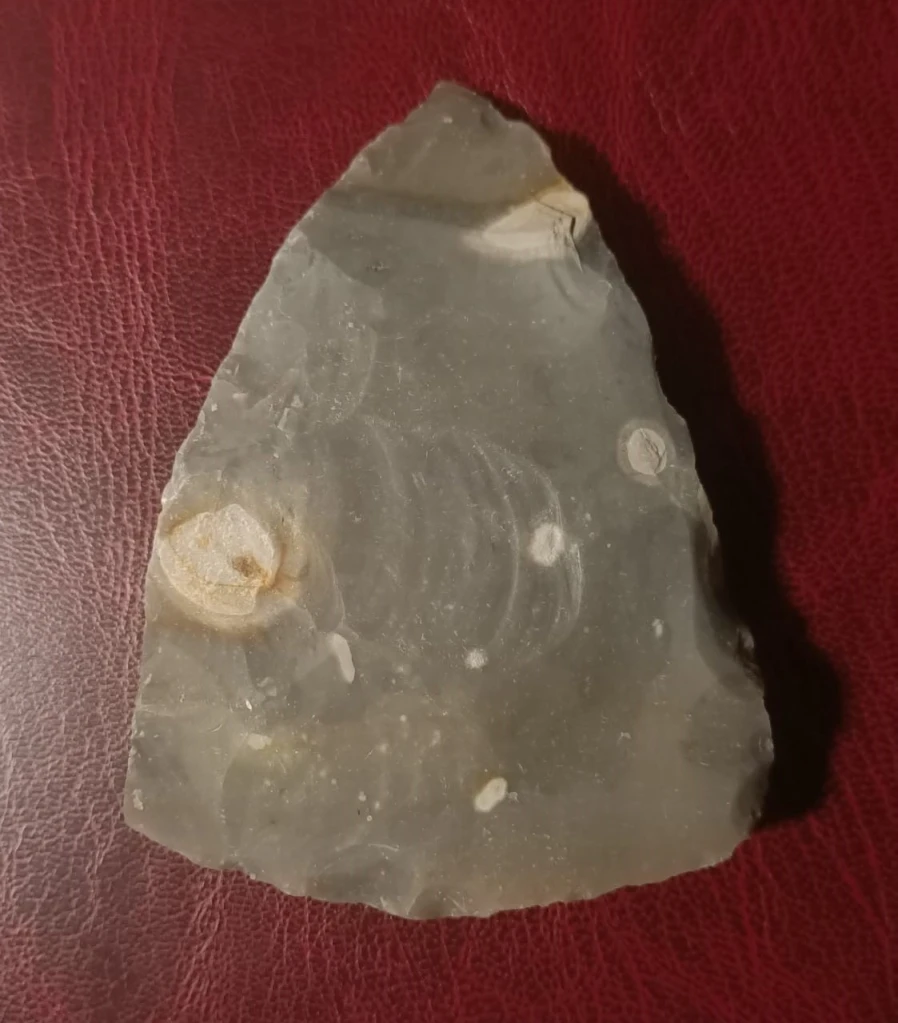
We had an excellent handaxe making workshop in the labs yesterday, and I will do a separate post about it when I get some feedback from participants. This post is about one small part of the session. Before the handaxe making started in earnest we watched a ten minute video of an American knapper produce a large handaxe from a flat tablet of Texas chert.
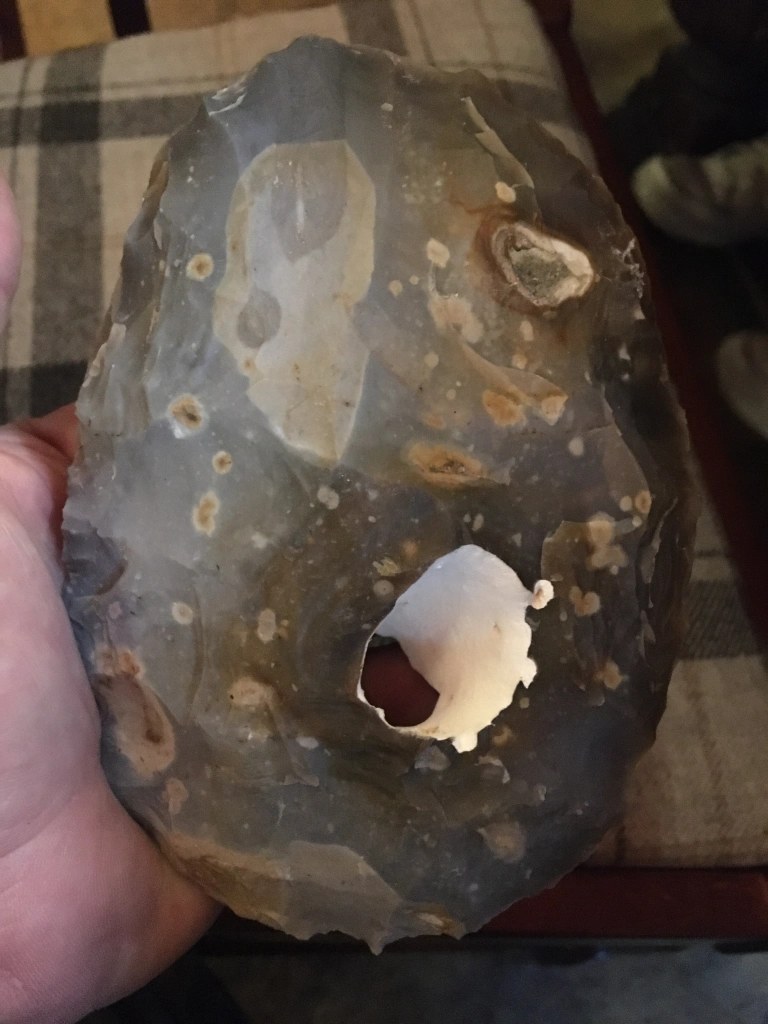
The American knapper was highly skilled and produced a long symmetrical handaxe within something like 25 removals. Impressive. However, I lost interest early on. We had looked at the handaxes in the teaching collection and these real examples were much less refined. In our session we were also using knobbly flint nodules from Norfolk with fossils, holes and differential texture throughout.
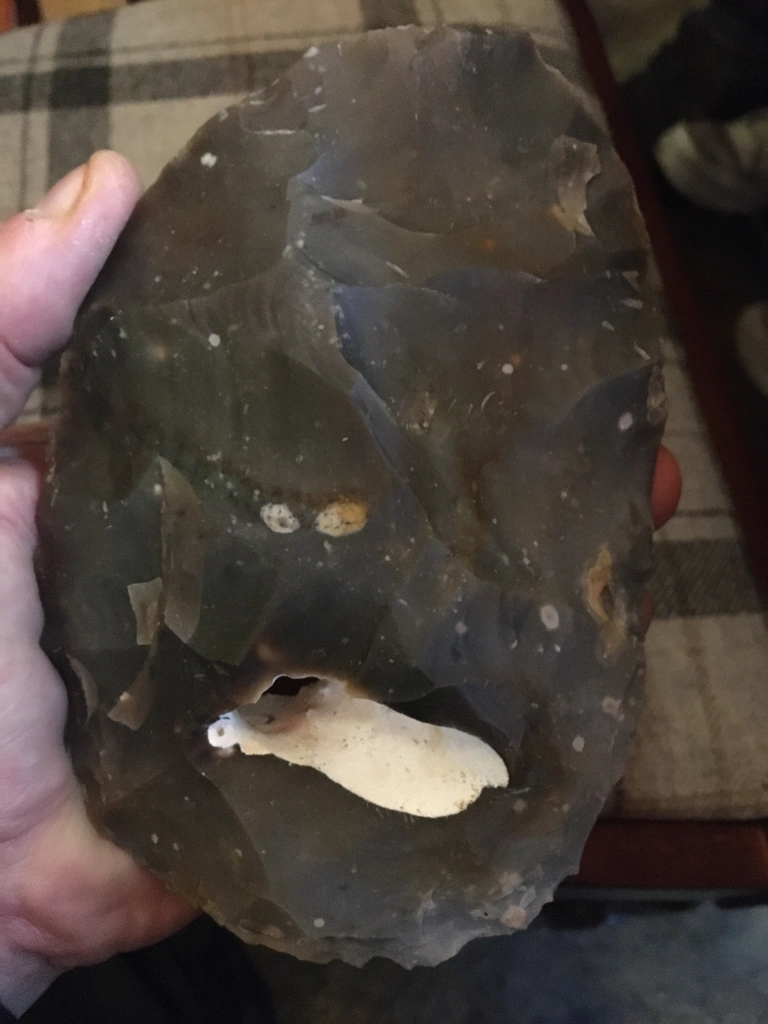
The video was a performance of control by a highly skilled knapper using high quality material of an optimum shape and size. The factors being controlled, size, shape, material quality, were exactly those we were negotiating. To me the video was a sales pitch to archaeologists looking for machine like knappers to take part in ‘scientific’ experiments.
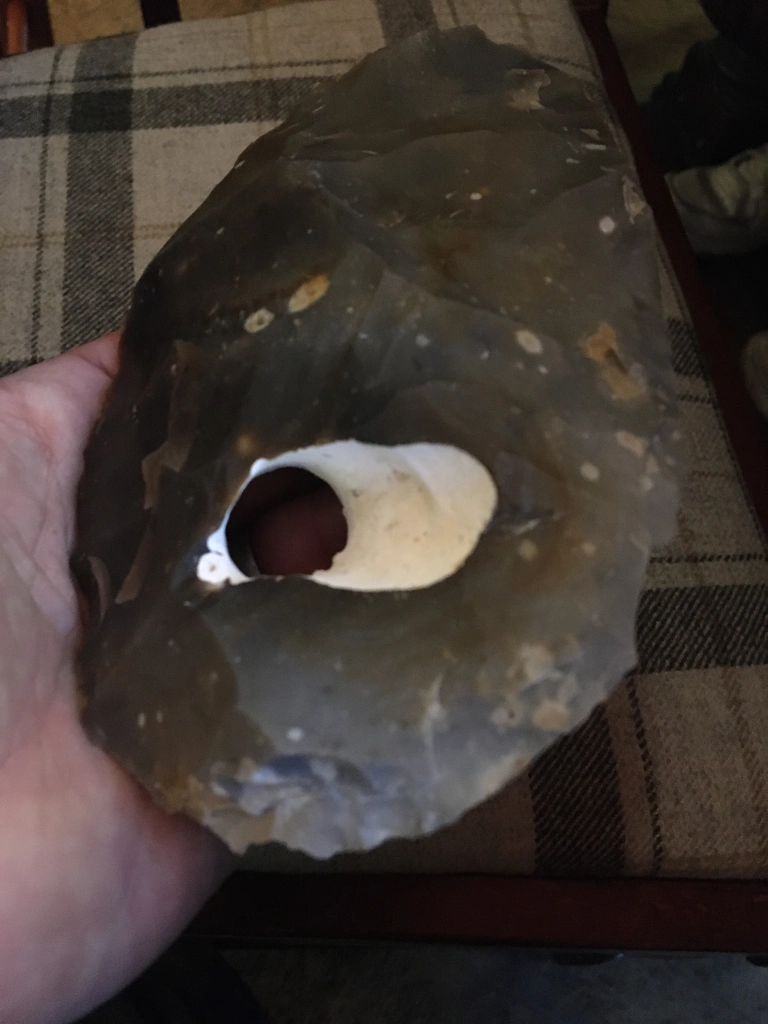
However, our exploratory negotiations with less than ideal materials resulted in artefacts much closer to the examples in the teaching collection. The handaxe in the photos was made before the workshop from a large flake with a big hole, small fossil, and course grained sections. My perspective is perhaps related to a current obsession with this brilliant track by the band James, describing the messiness of life and how we engage, make mistakes, change tack, and that we are ultimately, just getting away with it.
Whilst I felt the American knapper’s video was a performance of control, our knapping session was more like the performance of being human, and I loved it.
© 2025 Learning Through Making. All Rights Reserved.